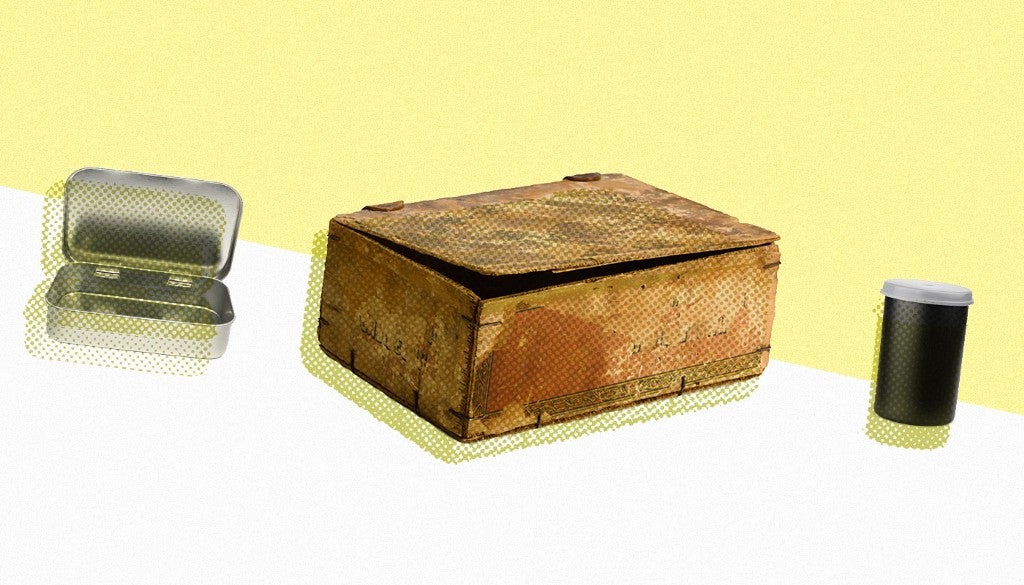At the outset of John Wick, a 2014 shoot-’em-up action flick that has become a cult classic among red-blooded American males, we learn that our wronged hero, played by Keanu Reeves, is more than a lonely widower grieving the death of his wife. He is, in fact, a retired but legendary assassin. As our crime-boss villain explains to his son what a powerful enemy he has made in Wick, we see Wick take a sledgehammer to the cement floor of his own basement.
It doesn’t take long to realize he’s digging up something. Nor do we need him to open a strongbox of guns and gold, the tools of his imminent revenge, to understand what we’re looking at: Every man has his stash.
True, most guys aren’t hoarding bullion and an arsenal of German-made firearms underneath their home. But the scene hinges nonetheless on a universal truth of the masculine brain: We like to have certain stuff set aside in a safe, specific place.
What kind of stuff? Important, surely. Valuable, of course — whether that means a dollar price or emotional attachment. All the same, not the kind of stuff you need to access on a regular basis; you just want to know where it is when you do. In one sense, the stash is for all the small things that have nowhere else to go: Your dad’s old cufflinks, awards from high school, a favorite deck of cards. It’s a junk drawer for junk that isn’t really junk.
The stash, though, is not without its demons — specifically, it’s where you keep what you’d rather not have someone else find: your Polaroids of exes, unpublished novels or drugs. This is why, when another person stumbles upon the stash, the situation can get awkward.
Once when I was away at college, my mom emailed to say that she had found a stash of mine — a woven pouch from a trip to Bolivia that held a baggie of weed and a couple of glass pipes — hidden in a hollow part of my bedroom’s easy chair. She wasn’t pleased, and threw out the pot. “I don’t want it in the house,” she said. But I could tell she also was embarrassed by her snooping, because she told me I could keep the pipes and pouch, in case they had sentimental worth. I’ve since lost track of them, which is fine, as I now keep all my cannabis and paraphernalia in a large wooden box, a stash that I let sit in plain sight, right next to the TV, daring any guest to take a peek.
https://twitter.com/soykawai/status/899996996504887296
With multiple secrets packed into a stash, it comes to resemble a private corner of one’s brain, a visual diary that speaks to pride and guilt alike. In this year’s breakout indie rom-com The Big Sick, comedian Kumail Nanjiani, playing a version of himself, is routinely exasperated by his mother’s efforts to arrange a match between himself and a suitable Pakistani-American woman. After each uncomfortable family dinner with a new suitress, Nanjiani receives a flattering photo to remember her by, which he files away in a box at home.
The ritual dramatizes his double anxiety: He doesn’t want an arranged relationship, but he stashes the photos instead of throwing them out — partly because his mother and these women have gone to such trouble, though also to preserve the option of calling someone from this archive. When his white girlfriend Emily finds the trove, she reads Nanjiani’s receipts, as it were, and figures out that he hasn’t told his family he’s dating her. His stash relates his uncertainties better than he ever does.
And so, we shouldn’t hide from the risks and contradictions of a stash. As a collection of trinkets and tokens from a life in progress, it keeps us honest, not just about where we’ve been but what we’ve tried to remember — people and places, triumphs and defeats. These items are not for display, and neither do they tend to serve a practical function; they are to be stored for some “later” moment. In assembling these objects and tucking them away together, we create a relevance between them, the various points of a narrative we either resist or inhabit.
As for what should a stash look like? That I cannot decide for you; the particulars of how a stash is maintained are as unique as what goes into it. A generally popular ideal, as the Nike-themed safe above may suggest, is the shoebox in the closet. Large enough to accommodate a range of small items, the shoebox remains an unassuming fixture in the right setting, failing to invite scrutiny. The cardboard grants a humble though durable confidentiality without sacrificing the chance to be vulnerable — with no lock on it, the spy is left to weigh the ethics of peeking inside, and it may come to be as attractively worn as the treasures within. And, assuming the box formerly contained a pair of your shoes, there’s a poetic symmetry here: Your metaphorical footprint inside the literal one.
Then, if the closet is indeed your preferred storage spot, you must decide where to put the shoebox. On the floor, for verisimilitude? Stacked on top of other boxes for convenience, or at the bottom, as an irreplaceable foundation stone? Up high on a shelf, where you have to grope blindly for it, and occasionally forget it exists? Under your bed is a suitable alternative, but don’t stop there. For years I kept a stash in a little basket at the back of my sock-and-underwear drawer, where my fingers brushed against it daily, reminding me of what I held dear as a teen — bronze pins from New Jersey state choir and swimsuit issues of Sports Illustrated I’d stolen from my brother.

Maybe in the end, that’s a stash’s best quality: protecting a set of minor mysteries in a boyish, mischievous way. After all, it’s hardly the end of the world if the details of the stash get out; for the most part, these aren’t damning records of deceit, betrayal and unspeakable urges, so having them under wraps is a matter of interior pleasure, not strict necessity. We don’t vocalize every thought and fantasy we have — we cannot hope to be fully transparent. The stash makes this fact tangible while forgiving the imperfection behind it. As puzzle pieces of our person, these odds and ends almost complete the picture.

